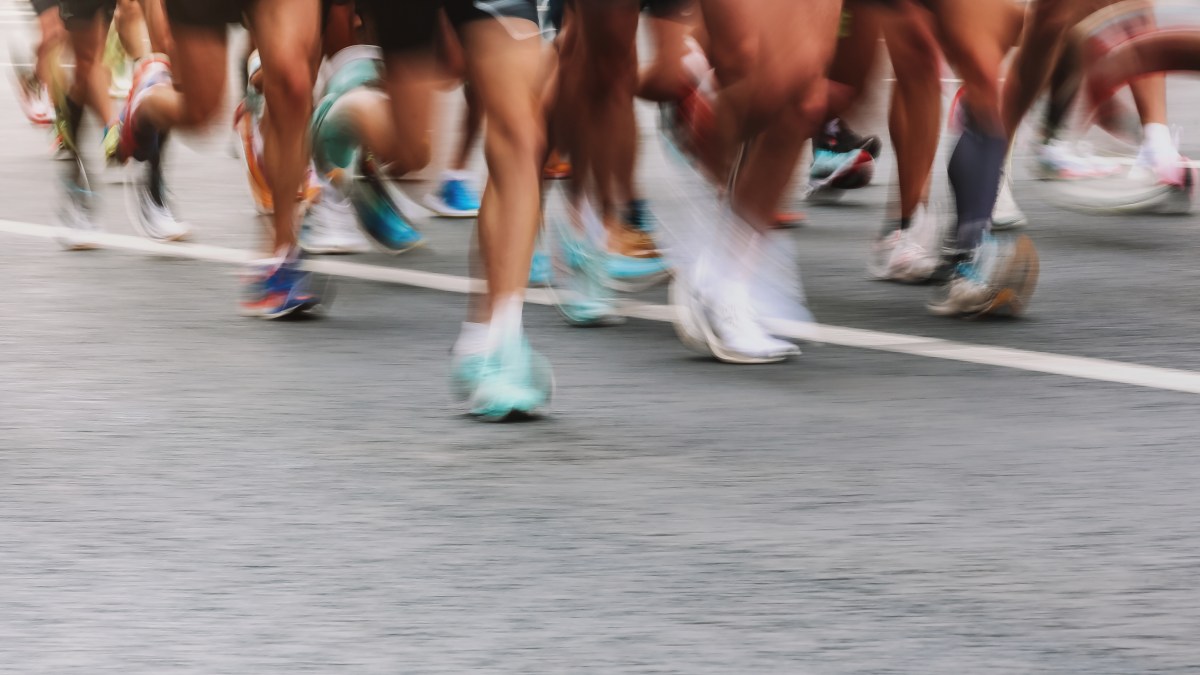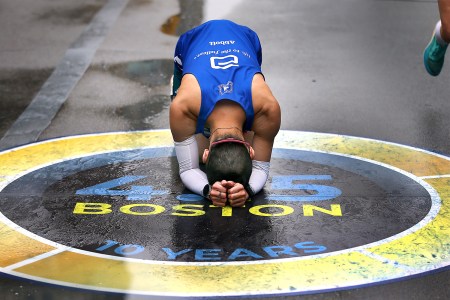There’s no shame in getting injured from running. According to Yale Medicine, over 50% of regular runners get hurt each year. And only a tiny fraction of those injuries are “impact,” like sudden tears or tumbles. Most are “overuse” — as the mileage mounts, so does a runner’s risk of straining their knees, calves or Achilles.
Of course, it’s difficult when your community’s premier activity is covering 26.2 miles on concrete. That sort of challenge — and all the training required to prepare for it — can get the best of anyone’s lower half…even one of the greatest endurance athletes ever.
It’s Never Too Late to Become a Runner. Here’s How.
Looking to get off the couch but no idea where to begin? We’ve got you.When Lance Armstrong ran the New York Marathon for the first time back in 2006, the seven–time Tour de France winner called the experience the hardest physical thing he’d ever done. The New York Times wrote at the time: “His dark green shirt was soaked with sweat, his gait stiff. He said his calves felt as if someone were squeezing them, hard. And his shin splints were flaring up again.”
Armstrong’s “shin splints” had actually turned into stress fractures, he and his team learned later. Either is capable of torpedoing a training program, or turning race day into a waking nightmare. But with dedicated, preventative training, it’s possible to run your marathon and enjoy it, too.
Here, we explain how to prevent the most common running injuries, including shin splits and stress fractures, along with four others that crop up constantly throughout the running community. We address them in order of prevalence below, with tips on how to prevent it and toys that might come in handy.
What Can We Learn From the “Post-Marathon Blues”?
Crossing the finish line can yield an oddly hollow feeling. What does it mean?1. Runner’s Knee
What to know: A dull and persistent pain at the front of the knee (the patella), right where it connects with the lower end of the femur. The cartilage tends to get irritated once you start running too far/fast/frequently, and in some cases, can even start to make a clicking noise every time you bend and unbend your knee. It’s the most common running-related injury, with an estimated prevalence of 25% among men.
How to prevent it: First and foremost, avoid any sudden increases in your training load. If you’re gearing up for a race, start your training early and increase at a sensible clip. Also: take time to reassess your form, making sure your knees aren’t pushing past your toes (try running with a slight forward lean). And invest in a pair of running shoes with midsole cushioning and excellent stability. New Balance and On have great options in that department.
A tip, tool, or toy: Knee misalignment tends to happen when the muscles and ligaments around the knee are inflexible and/or weaker than they need to be. Regular strength training focusing on the hips and quadriceps can go a long way here — get yourself a foam roller for releasing tightness, and consider familiarizing yourself with a balance board, which will improve lower limb “proprioception” and stability.
2. Shin Splints
What to know: Second on this list, but a malady that everyone knows well. As one Reddit user aptly summarized: “[Shin splints] kind of feels like you have a bruise, and someone is squeezing on it every time you take a step.” That pain manifests on account of repetitive stress on both the shinbone itself (the tibia), and the tissues connecting it to the surrounding muscles.
How to prevent it: Similar prescription here — refrain from increasing mileage by more than 10% a week, find the right footwear (cushioning is paramount here, try Hoka or Brooks) and prioritize exercises that will strengthen/release your lower leg muscles. Focus specifically on the calves, by skipping rope, performing simple calf raises and trying weighted “toe walks.”
A tip, tool, or toy: There are ice packs out there designed explicitly to relieve shin splint pain. (They look like a baseball catcher’s leg pads…except you put them in the freezer). Apply them to the shins to reduce inflammation. Try 15-minute sessions, a few times a day, for up to a week or more as your body adjusts to the rigors running.
3. Plantar Fasciitis
What to know: Plantar fasciitis comprises about a tenth of the running injury pie, but it’s probably the most nagging and notorious. An inflammation of the band of tissue (the plantar fascia) that extends from the heel to the toes, it often leads to intense foot and heel pain in runners. What’s worse: sufferers of “Frisco” experience it at its worst in the morning — right when most people have time to go for a run — due to a lack of foot engagement while sleeping.
How to prevent it: If you have plantar fasciitis, chances are you need a pair of shoes with excellent arch support, so handle that right away. Do not run those shoes into the ground. And skip barefoot running, too (no matter how fun it looks). Also: make sure to stretch your calves and feet all the time, and consider yoga poses like Dandasana, or Adho Mukha Svanasana, which specifically target the feet.
This Chart Will Simplify Your “Recovery Fitness” Routine
Some strategies help heal the body. Others are a waste of time.A tip, tool, or toy: A $5 pack of lacrosse balls will come in handy here, though feel free to splurge on a vibrating foot massage roller — there are plenty on the marker these days. Simply rolling your plantar fascia against something spherical and solid will help relieve some of the pain. Plus, regular use of toe separators could help maintain proper foot alignment and relieve strain, too.
4. IT Band Syndrome
What to know: IT Band Syndrome primarily occurs due to runners’ biomechanical deficiencies. These are natural and common failings — stuff like crossing your feet from time to time, rotating your thigh bone inward, or over-relying on one side of the hips — but they take their toll. The iliotibial band, a thick tendon that runs from your hip to the outside of your knee, essentially turns taut and inflamed over time. It can lead to complications in your hips or knees.
How to prevent it: For starters, avoid running exclusively on one side of the road. The dip in the road (so rainwater can travel to the sewers) might not register as you’re running, but it’ll exacerbate imbalances in your form and increase stress on the IT band. Also useful: specific stretches to open up the IT band and prevent it from rubbing against bone (the side-lying IT band stretch is considered best), proper cool downs after more intense efforts and a discerning approach to downhills or uneven terrain, which tend to wreak the most havoc on the area.
A tip, tool, or toy: Though a foam roller can also work wonders, this is where you deploy your expensive massage gun. Float it along the IT band for a few minutes at a time, before and after runs.
5. Achilles Tendonitis
What to know: This refers to the degeneration of the Achilles tendon, the band of tissue that connects calf muscles at the back of the lower leg to your heel bone. It’s telling that this injury is common amongst runners and people who don’t exercise (or only exercise once in a while).
How to prevent it: You’ll want a running shoe that blends arch support, stability and cushioning, especially in the heel. Some physicians might advise heel cups or inserts, in case your shoe can’t get the job done on its own. Otherwise — and you may have started to register a through line here — it’s really important to stretch and strengthen your lower half, especially your calves. Be mindful of hillier runs (which tax the calves, and the heel, in kind), and again, don’t try to shock the body by increasing mileage over night.
A tip, tool, or toy: Use a resistance band to increase the flexibility and resilience of your calves and Achilles. We can specifically vouch for (a) seated calf raises and (b) targeted Achilles stretches. Both involve sitting down and wrapping the resistance band around your feet. For the former, push against the band 10 to 15 times, for three sets. For the latter, pull the foot towards you and hold for 30 seconds, for three sets.
6. Stress Fractures
What to know: Not what you want. This is the inflection point at which injuries turn into other, more serious injuries. Stress fractures are tiny cracks in a bone caused by overuse or repetitive force, often from overtraining. Unsurprisingly, they’re most common in “weight-bearing bones” — feet and the lower legs. The only group that logs stress fractures at a rate similar to runners are military personnel, who are known to carry weights of 70 pounds or more over 12 miles.
How to prevent it: Fortunately, you have to really increase your running load, somewhat out of nowhere — and subsequently ignore constant signals of pain — in order to develop a stress fracture. In retrospect, it isn’t particularly surprising that a low-impact athlete like Lance Armstrong, so used to pushing himself to an extreme degree, came down with this injury. You’re at a higher risk of stress fractures if you start from a place of low bone density, so make sure to load up on calcium and Vitamin D as you ramp up training.
A tip, tool, or toy: Cross-training is also your best friend here. Angle for aquatic exercise, in particular, which can provide a low-impact workout alternative for staying fit, while affording your bones a chance to rest.
Whether you’re looking to get into shape, or just get out of a funk, The Charge has got you covered. Sign up for our new wellness newsletter today.

































